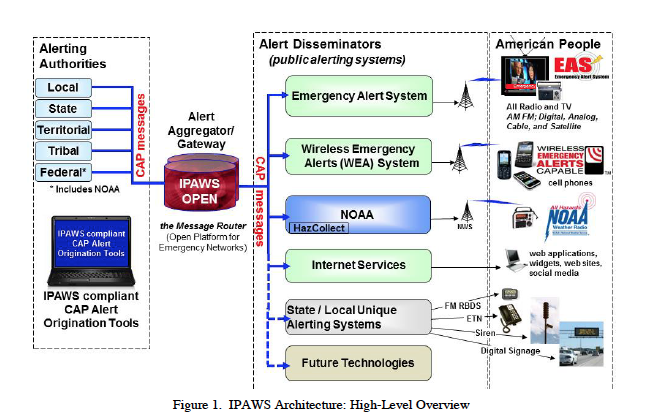It’s not like we don’t hear from our president often enough.
But Uncle Sam—having failed to devise its own system that could put the president’s words out to all citizens within minutes—is reaching out to the private sector for help.
His goal? So the “President of the United States can alert and warn the American people under all conditions.”
How quickly? Within 10 minutes, and preferably within five.
How reliably? Messages must get through 99.99% of the time, and ideally have a 99.999% “continuously operating availability performance level.”
How? Via radio and television, to be sure. But the government also wants to reach you through cell phones, social media like Facebook and Twitter, local alert systems, smart appliances and electronic highway signs. “Together with legacy systems, these technologies can create a multi-channel, multi-media approach to keeping the public informed of imminent threats and all hazards,” the Federal Emergency Management Agency said in a Friday announcement seeking outside help to accomplish the task.
“All hazards”?
Apparently, the world has become so dangerous—and Americans, to put it bluntly, so stupid—that the federal government has concluded that it is vital that the president or other “authenticated public safety officials” be able to tell you what to do right now. Kind of like the loudspeakers the North Korean government has wired into every home. Only wireless, too.
But it’s refreshing to hear the Federal Emergency Management Agency (FEMA) and the Department of Homeland Security (DHS) concede they can’t run their Integrated Public Alert and Warning System (IPAWS) on their own:
The current FEMA and DHS infrastructures…[have] actually disabled IPAWS’s responsiveness and flexibility at times and prevented IPAWS from carrying out its mission…The collective risk of the current system architecture is too great for IPAWS and our nation…an aggregate risk that is incalculable…Given the right set of events, all of the…risks could converge, creating a perfect storm event: i.e., (Federal partners disabled + state and local partners disabled + tribal and territorial partners disabled). Such an event could have a disastrous impact with unimaginable local, regional or national consequences…”
Phew!
A test of the system in 2011, limited to radio and television, didn’t instill much confidence in the government’s ability to get the word out. Many channels and stations didn’t broadcast the test Emergency Alert System message. “This initial test was the first time we have tested the reach and scope of this technology and additional improvements that should be made to the system as we move forward,” the government said back then. “Only through comprehensively testing, analyzing and improving these technologies can we ensure an effective and reliable national emergency alert and warning system.”
This ability to reach out and touch everyone stems from an executive order issued by President George W. Bush in 2006 requiring “that under all conditions the President of the United States can alert and warn the American people” about “war, terrorist attack, natural disaster, or other hazards to public safety and well-being” (No, government intrusion into the lives of U.S. citizens wasn’t deemed a hazard). The explosion in technology requires smart thinking “to improve public alert and warning over more media, to the most people, at all times, in all situations,” FEMA said in Friday’s announcement.
It’s part and parcel of the post-9/11 mentality that suggests Americans should be cowering in fear, awaiting information from on high so they can do the right thing. While the urge to help is admirable, the mission statement kind of reads like footnotes in George Orwell’s 1984:
— Timeliness: IPAWS shall have the capability to disseminate a Presidential message within ten minutes from its receipt.
— Availability/Reliability/Maintainability: IPAWS shall have an availability of 99.99% to support the ten-minute Presidential capability to alert and warn the American people under all conditions. IPAWS shall provide reliable communications by employing redundancy and diversity, including deployment in at least two data centers. This redundancy shall ensure effective, enduring communications across a host of potentially challenging circumstances. This requires that sufficient numbers of deployed hardware, software and network components, provided in a geographically diverse and redundant manner, are in place to ensure high reliability and availability. IPAWS system resilience focuses on those efforts needed to maximize the President’s ability to communicate with the American people pre-, during, and post-event, or as soon as possible thereafter.
— Support for Languages and Geographic Alert Targeting: IPAWS shall have the capability to provide alerts and warning to all Americans including those with disabilities and without an understanding of the English language. IPAWS shall also have the capability to adapt the distribution and content of communications based on geographic location.
— Interoperability: IPAWS supports integration of alert and warning distribution pathways among federal, state and local systems, networks, and emergency operations entities. Interoperability is achieved by using common aggregation points and gateways to bridge the gaps between diverse technologies. Standards ensure the technology can interface and communicate across various systems and networks. In particular, a specialized Extensible Markup Language (XML) format, the Organization for the Advancement of Structured Information Standards (OASIS) standards-based CAP protocol is used for alert and warning creation to ensure interoperability. These alerts aggregate at a common enterprise service bus, where alert and warnings can be stored, audited and managed. System components shall support interoperability via an open architecture / non-proprietary network protocol. As IPAWS interconnects additional networks, the system as a whole increases its interoperability, reliability, and connectivity.
Did you catch that sentence? “These alerts aggregate at a common enterprise service bus, where alert and warnings can be stored, audited and managed.”
In other words, some of the warnings are going to be preloaded, awaiting a call from the White House to broadcast them instantly nationwide. Or, perhaps such a transmission might be triggered by a technical snafu.
Think of it as the Affordable Scare Act.


